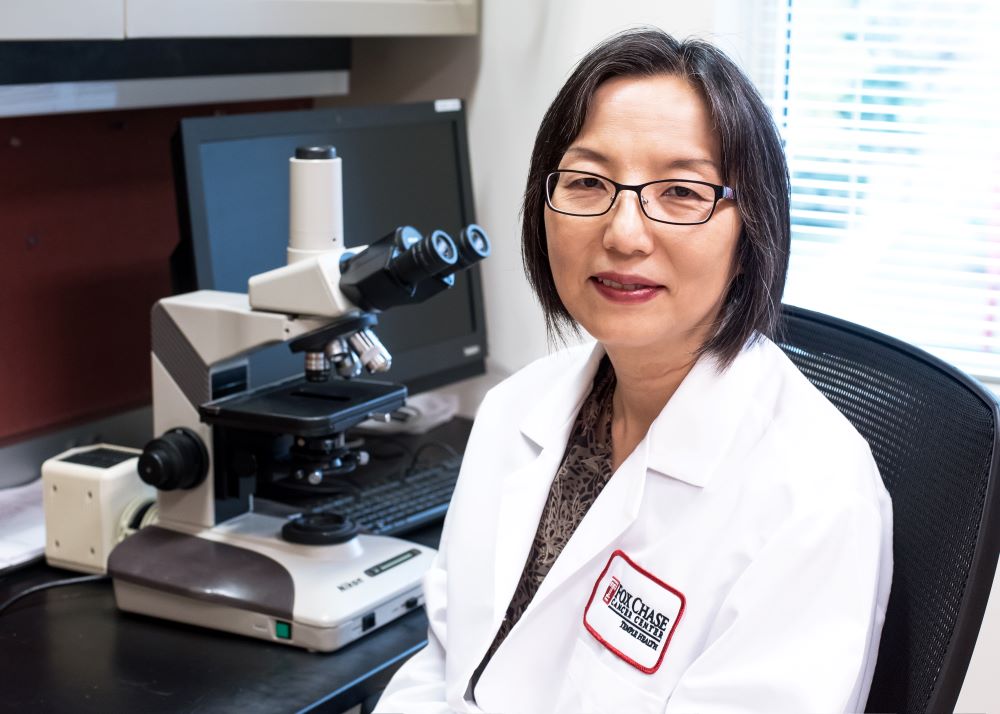
PHILADELPHIA (August 12, 2025) — In a recently published study, researchers at Fox Chase Cancer Center revealed for the first time that cancer cells can evade anti-cancer drugs by entering and surviving within bone marrow fibroblasts, a phenomenon they describe as “cell-in-cell.”
The results of this five-year study, led by Y. Lynn Wang, MD, PhD, FCAP, a Professor and physician-scientist in the Department of Pathology and the Cell Signaling and Microenvironment Research Program at Fox Chase, could mark a major change in the treatment of chronic lymphocytic leukemia (CLL) and related diseases. CLL is the most common hematological cancer in western countries.
“Our discovery that tumor cells can actually get inside bone marrow fibroblast cells, which support the tumor cells in their microenvironment, has never been reported before as a live phenomenon,” said Wang.
“This finding helps to explain why, even when CLL patients initially respond to treatment, many of them carry residual disease and later relapse. We are hopeful that our discovery will lead to treatments that better eliminate residual disease and move toward a cure for cancer,” added Wang, who conducted the study with researchers at Fox Chase and other institutions.
BTK inhibitors, a class of anti-cancer drugs, are the current standard of care for CLL. Over 90% of patients who are treated with these drugs show an initial response — they feel better and their tumors shrink — but only 8% to 11% achieve complete remission in which clinically patients show no evidence of disease. This means that a high number of patients carry residual disease that leaves them vulnerable to relapse. Wang and her team wanted to understand how the disease manages to persist in spite of good initial response to the drugs.
Using confocal microscopy and other techniques, the researchers analyzed bone marrow samples from patients. They witnessed live CLL cells entering bone marrow fibroblasts in response to BTK exposure, and by recording continued independent movement of those subsumed cells, they were able to confirm that the cancer cells stayed alive inside the fibroblasts. Wang’s team then demonstrated that the cancer cells hiding inside the fibroblasts had higher survival rates compared to the cells that remained outside the fibroblasts exposed to the drug.
“It’s like the tumor cells are retreating off the street into a house where they’re safer from the street bullies, i.e., the drugs,” Wang said.
The way CLL cells do this, her team found, is by increasing the expression of CXCR4, a receptor protein on the surface of the tumor cells, in response to exposure to BTK inhibitors. The expression of this protein makes tumor cells sense a chemical gradient that draws the tumor cells closer to the fibroblasts that secrete the ligands for the receptor, allowing the former to enter the latter.
Once Wang and her team understood the mechanism by which tumor cells got inside their “safe houses,” they were able to demonstrate how clinicians might alter treatment to stop this from happening. By blocking CXCR4 with drugs approved for other clinical indications, the researchers prevented CLL cells from entering fibroblasts, potentially making the cancer more vulnerable to treatment.
“If we can block CXCR4, it’s like locking the door of the house where tumor cells wanted to retreat and hide,” said Wang. “This could potentially increase complete response rates through combination therapy using both BTK inhibitors and CXCR4 blockers.”
The discovery may also have applications beyond CLL. The researchers found similar “cell-in-cell” hiding behavior in follicular lymphoma and suspect the mechanism could apply to many different cancer types. Wang is encouraged about the potential of her team’s discovery.
“We want the larger scientific community to know about this mechanism so other researchers can build on these findings. If we can understand what makes cancer cells persist as residual disease, we can better treat cancer and move toward the ultimate goal of cancer elimination.”
The paper, “Shelter in Place: Live CLL Cells Inside the Bone Marrow Fibroblasts and Its Implication in Residual Disease Persistence,” was published in Blood Neoplasia, one of the official journals of the American Society of Hematology.